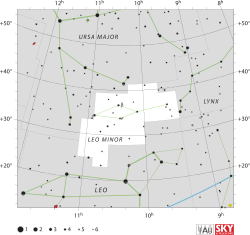46 Leonis Minoris
| Observation data Epoch J2000 Equinox J2000 | |
|---|---|
| Constellation | Leo Minor |
| Right ascension | 10h 53m 18.70487s[1] |
| Declination | +34° 12′ 53.5375″[1] |
| Apparent magnitude (V) | 3.83[2] |
| Characteristics | |
| Spectral type | K0+III-IV |
| Astrometry | |
| Proper motion (μ) | RA: +92.02[1] mas/yr Dec.: –285.82[1] mas/yr |
| Parallax (π) | 34.38 ± 0.21 mas[1] |
| Distance | 94.9 ± 0.6 ly (29.1 ± 0.2 pc) |
| Details | |
| Radius | 8.2 ± 0.2[2] R☉ |
| Luminosity | 34 ± 2[2] L☉ |
| Surface gravity (log g) | 2.96[2] cgs |
| Temperature | 4,670[2] K |
| Other designations | |
46 Leonis Minoris (46 LMi) is the brightest star in the constellation Leo Minor. It is sometimes known as "o LMi" (not "ο LMi"), from Bode's catalogue of 1801. It was presumably intended to be designated α, as Francis Baily decided to letter each star brighter than magnitude 4.5, but the designation was missing from his catalogue, even though the dimmer β was included.[3]
It has the proper name Praecipua, the Latin "the Chief (Star of Leo Minor)".[4] The name may originally have referred to 37 Leonis Minoris, and later mistransfered to this star.[5]
It is known as 勢四, "the Fourth (Star) of the Eunuch", in traditional Chinese astronomy.
46 LMi has spectral class K0+III-IV and is of magnitude 3.83. Its distance from Earth is approximately 95 light years.
References
- ^ a b c d e van Leeuwen, F. (2007), "Validation of the new Hipparcos reduction", Astronomy and Astrophysics, 474 (2): 653–664, Bibcode:2007A&A...474..653V, doi:10.1051/0004-6361:20078357
{{citation}}: Unknown parameter|month=ignored (help) - ^ a b c d e Piau, L.; et al. (2011), "Surface convection and red-giant radius measurements", Astronomy and Astrophysics, 526: A100, Bibcode:2011A&A...526A.100P, doi:10.1051/0004-6361/201014442
{{citation}}: Unknown parameter|arXiv=ignored (|arxiv=suggested) (help) - ^ Wagman, Morton (2003). Lost Stars. Blacksburg, Virginia: McDonald and Woodward. ISBN 0-939923-78-5.
- ^ Allen, R. H., (1963). Star Names: Their Lore and Meaning (rep. ed.). New York, NY: Dover Publications Inc. p. 264. ISBN 0-486-21079-0.
{{cite book}}: CS1 maint: extra punctuation (link) CS1 maint: multiple names: authors list (link)[1] - ^ Leo Minor: The little lion- Ian Ridpath's Star Tales

